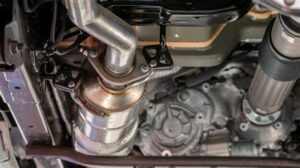Are you a proud Toyota owner seeking to enhance your vehicle’s performance and maintain its environmental compliance? Understanding the importance of the Cadillac converter is essential for every driver. This crucial component plays a significant role in reducing harmful emissions while optimizing engine efficiency. In this article, we will delve into what a Cadillac converter is, how to identify signs of a faulty converter, and its vital role in emission control. We’ll also explore the benefits of replacing a Cadillac converter and answer some frequently asked questions to ensure you have all the information you need. Join us on this journey to better understand your Toyota’s Cadillac converter and learn how to keep it running smoothly for years to come.
Understanding The Cadillac Converter In Toyota Vehicles
The cadillac converter is an essential component in Toyota vehicles, playing a crucial role in reducing harmful emissions and ensuring compliance with environmental regulations. It is a part of the vehicle’s exhaust system, designed to convert toxic gases produced during combustion into less harmful substances before they are released into the atmosphere.
In essence, the cadillac converter uses a chemical reaction to transform harmful pollutants such as carbon monoxide, hydrocarbons, and nitrogen oxides into carbon dioxide and nitrogen, which are much less damaging to the environment. This conversion process is facilitated by a catalyst, typically made from precious metals such as platinum, palladium, and rhodium.
Different Toyota models may feature various types of cadillac converters, including two-way, three-way, and compact designs, depending on their emissions requirements and engine specifications. Understanding how the cadillac converter works in your specific Toyota model can help you maintain optimal performance and address any potential issues that may arise over time.
| Type of Converter | Description |
|---|---|
| Two-way Converter | Used primarily in older vehicles, it handles oxidation of carbon monoxide and hydrocarbons. |
| Three-way Converter | The most common in modern vehicles, it reduces nitrogen oxides along with carbon monoxide and hydrocarbons. |
| Compact Converter | Designed for smaller engines, providing effective emission control in a space-efficient manner. |
Regular maintenance and inspection of the cadillac converter are crucial for the longevity of your Toyota vehicle. Issues with the converter can lead to increased emissions, reduced fuel efficiency, and potential damage to other components in the exhaust system. Understanding how it operates will empower you to recognize early signs of failure, ensuring timely repairs and replacements when necessary.
How To Identify A Faulty Cadillac Converter
Identifying a faulty cadillac converter in your Toyota is crucial for maintaining your vehicle’s performance and ensuring compliance with emission standards. Here are some signs and methods to help you determine whether your cadillac converter is malfunctioning:
- Check Engine Light: One of the most common indicators of a faulty cadillac converter is the illumination of the check engine light. If this light appears, it’s important to have your vehicle diagnosed as soon as possible.
- Decreased Engine Performance: If you notice that your Toyota is struggling to accelerate, or if it feels sluggish when driving, this could be a sign that the cadillac converter is clogged or damaged.
- Unusual Exhaust Odors: A failing cadillac converter can produce strong sulfur smells, akin to rotten eggs. If you experience this odor, it’s likely a sign of a problem.
- Excessive Exhaust Emissions: If your vehicle is emitting excessive pollutants or producing visible smoke from the exhaust, it may indicate a malfunctioning cadillac converter.
- Abnormal Noises: If you hear rattling noises coming from underneath your vehicle, it might suggest that the materials within the cadillac converter are breaking apart.
- Failed Emissions Test: If your vehicle fails an emissions test, it could be due to a faulty cadillac converter. This is especially relevant if all other systems are functioning correctly.
Regular maintenance and attention to these signs can save you from costly repairs and keep your Toyota operating efficiently. If you suspect your cadillac converter is faulty, consult a professional mechanic for a thorough inspection. Early intervention is key to avoiding more serious issues down the road.
The Role Of Cadillac Converters In Emission Control
The cadillac converter plays a crucial role in the emission control system of Toyota vehicles. Its primary function is to reduce harmful gases emitted from the engine, ensuring compliance with environmental regulations and standards. By converting toxic substances such as carbon monoxide, hydrocarbons, and nitrogen oxides into less harmful emissions, the cadillac converter contributes significantly to improving air quality.
Here’s how the process works:
| Emission Component | Converted Component |
|---|---|
| Carbon Monoxide (CO) | Carbon Dioxide (CO₂) |
| Hydrocarbons (HC) | Water (H₂O) and Carbon Dioxide (CO₂) |
| Nitrogen Oxides (NOx) | Nitrogen (N₂) and Oxygen (O₂) |
By facilitating these conversions, the cadillac converter not only helps in the fight against pollution but also enhances fuel efficiency and overall vehicle performance. An efficiently functioning cadillac converter ensures that your Toyota remains within the emissions standards set by regulatory bodies, which is increasingly important in today’s environmentally conscious society.
Signs That Indicate A Cadillac Converter Needs Replacement
Over time, the cadillac converter in your Toyota may wear down or become damaged, leading to various symptoms that signal it’s time for a replacement. Here are the key signs to look out for:
- Reduced engine performance: If you notice a significant decrease in your vehicle’s acceleration or overall power, this could indicate a failing cadillac converter.
- Check engine light: A persistent check engine light can signal issues with the cadillac converter. Use an OBD-II scanner to check for diagnostic trouble codes related to the converter.
- Strange noises: Unusual sounds, such as a loud rumbling or clanging noise from underneath the vehicle, may suggest that the cadillac converter is damaged or clogged.
- Excessive exhaust emissions: If your Toyota emits an offensive smell or visible exhaust smoke, a malfunctioning cadillac converter could be to blame.
- Decreased fuel efficiency: If you find yourself filling up more often than usual, a failing cadillac converter may be affecting your fuel economy.
Addressing these signs promptly can help prevent further damage to your vehicle and ensure that your Toyota remains compliant with emission standards. If you experience any of these symptoms, consider having your cadillac converter inspected and replaced if necessary.
Benefits Of Replacing A Cadillac Converter In Your Toyota
Replacing a cadillac converter in your Toyota can lead to numerous advantages, ensuring your vehicle operates efficiently and adheres to emission standards. Here are some of the key benefits:
Maintaining and replacing your Toyota’s cadillac converter when necessary can lead to improved performance, better fuel economy, reduced emissions, and ultimately, a more reliable vehicle.
Frequently Asked Questions
What is a catalytic converter and why is it important for Toyota vehicles?
A catalytic converter is an essential component of a vehicle’s exhaust system that reduces harmful emissions by converting toxic gases into less harmful substances. It is crucial for Toyota vehicles to meet environmental regulations and improve fuel efficiency.
How do I know if my Toyota’s catalytic converter is failing?
Signs of a failing catalytic converter in a Toyota may include a drop in fuel efficiency, a sulfuric smell, unusual sounds from the exhaust, and warning lights on the dashboard such as the check engine light.
Can I drive my Toyota without a catalytic converter?
Driving a Toyota without a catalytic converter is not recommended as it can lead to increased emissions, potential legal issues, and a failure to pass emissions tests, which may result in fines or penalties.
What are the common causes of catalytic converter failure in Toyota vehicles?
Common causes of catalytic converter failure in Toyota vehicles include engine misfires, oil or coolant leaks, and using poor-quality fuel which can lead to contamination and clogging.
Is it possible to replace a Toyota catalytic converter myself?
While it is possible to replace a Toyota catalytic converter yourself if you have the necessary skills and tools, it is often recommended to seek professional help to ensure proper installation and compliance with emissions regulations.
What are the differences between OEM and aftermarket catalytic converters for Toyota?
OEM (Original Equipment Manufacturer) catalytic converters are made by Toyota and designed specifically for their vehicles, ensuring perfect fit and function. Aftermarket catalytic converters may be less expensive but can vary in quality and may not meet OEM standards.
How can I extend the life of my Toyota’s catalytic converter?
To extend the life of your Toyota’s catalytic converter, maintain your vehicle regularly, address engine issues promptly, use high-quality fuel, and avoid driving with a faulty exhaust system to prevent overheating or damage.





